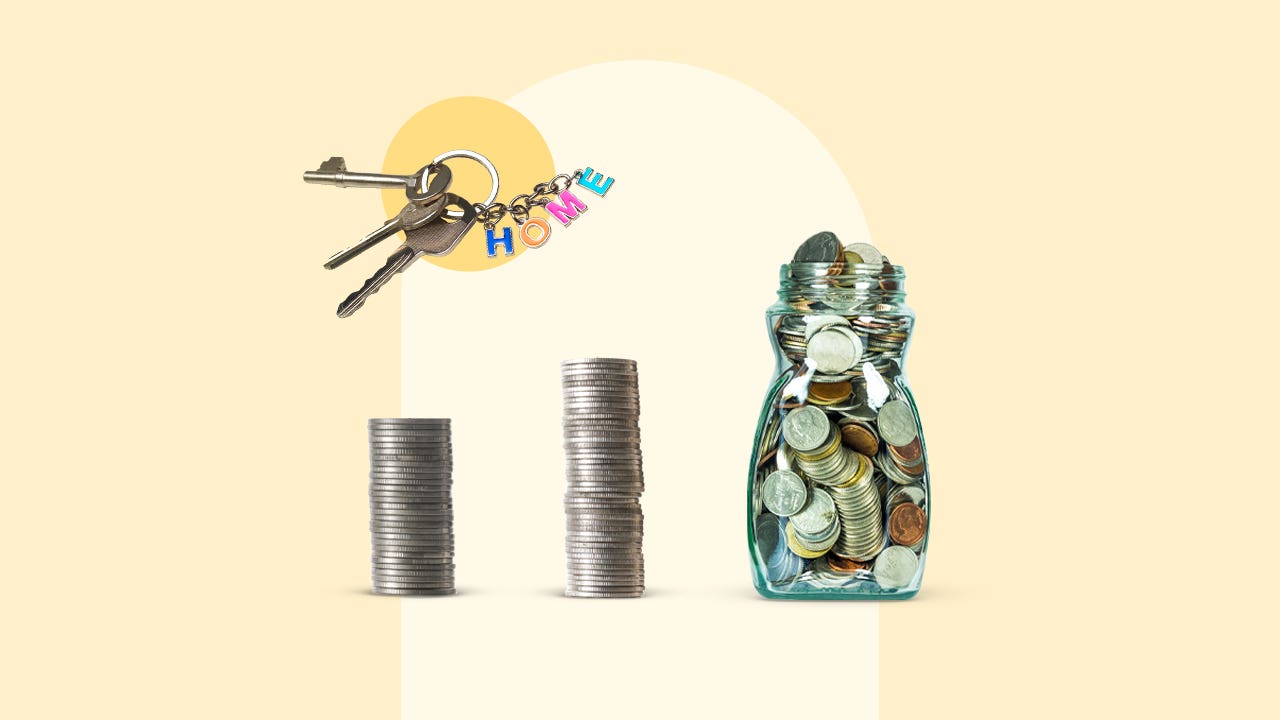Survey: More than half of aspiring homeowners say cost of living, low income hold them back

More than half of aspiring homeowners say living costs are too high or their incomes are too low to squeeze a down payment and closing costs into their budgets, according to Bankrate’s new Down Payment Survey.
Reflecting the bout of inflation that swept through the economy in 2022 and 2023, fully 51 percent of would-be homeowners say the cost of living poses an obstacle to their home-buying plans. Meanwhile, 54 percent of Americans say their incomes haven’t kept pace with home prices that are flirting with record levels.
“With so many aspiring homeowners saying they’re not making enough money to afford a down payment, the job market has been more resilient, the economy more robust than many experts expected,” says Mark Hamrick, Bankrate’s chief economic analyst. “That strength can still be leveraged.”
Bankrate’s key takeaways
- Myriad financial challenges vex would-be buyers. In addition to the high cost of living and low income, aspiring homeowners cited these barriers to homeownership: credit card debt (18 percent); friends or family not being able to provide financial assistance (15 percent); and student loan debt (10 percent).
- Saving up could take a long time. Fully 20 percent of aspiring homeowners think they will never be able to save enough to purchase a home. Just 7 percent say they’ll be ready in less than a year.
- Successful buyers were intentional about achieving their goal. More than four in 10 current homeowners (41 percent) saved specifically for the down payment and closing costs on their first homes, and 14 percent got down payment assistance or a first-time buyer grant.
- Americans’ housing outlook is growing less gloomy. Overall, 42 percent believe now is a bad time to buy a home, a decrease from 49 percent in September 2023.
Many say high living costs, constrained incomes pose challenges
More than half of aspiring homeowners say the current cost of living is too high or their income is not high enough for them to afford a down payment and closing costs for a home (51 percent and 54 percent, respectively).
In addition to the high cost of living and low income, aspiring homeowners cited credit card debt (18 percent), friends or family not being able to provide financial assistance (15 percent) and student loan debt (10 percent) as barriers to homeownership, while 8 percent cited some other reason. Just 13 percent of aspiring homeowners said nothing is holding them back.
Younger aspiring homeowners are more likely to point to a lack of financial assistance from friends or family as obstacles to homeownership compared to older generations, while millennials are most likely to point to both credit card and student loan debt.
Aspiring homeowners not hopeful they’ll be able to afford to buy in near future
Fully 20 percent of aspiring homeowners think they will never be able to save enough to purchase a home. Older generations (36 percent of baby boomers and 28 percent of Gen Xers) are more likely to believe they will never be able to save enough to buy a home, compared to 18 percent of millennials and 10 percent of Gen Zers.
Nearly one-third of aspiring homeowners (30 percent) say it will take at least five years or longer to save enough money for a home, while 10 percent say it will take a decade or more.
Americans more optimistic about housing market
Overall, 42 percent believe now is a bad time to buy a home, a decrease from 49 percent in a September 2023 Bankrate survey.
Among other housing market headwinds, nearly two in five (39 percent) say they think mortgage rates will remain elevated for the foreseeable future, while 38 percent say a buyer needs excellent credit to get a mortgage and 17 percent say that renting is cheaper than buying a home.
Current homeowners got there through intentional savings
When asked how they came up with the cash for their first homes, 41 percent of current homeowners saved specifically for that purpose, 14 percent received a gift from family or friends and another 14 percent used a first-time homebuyers grant or loan assistance program. Nine percent received a loan from family or friends, while another 9 percent took money out of retirement savings. Fewer homeowners found additional income streams (8 percent) or sold some personal items such as jewelry, electronics or cars (7 percent).
3 ways to save for a down payment
- Leverage a savings account. Although mortgage rates have increased, the rates on savings accounts have gone up, too. Look into high-yield or money market accounts, or even a certificate of deposit, to take advantage of these returns.
- Don’t sweat 20 percent. While 20 percent is an ideal amount to put down, the reality is that the typical home price nationally is close to $400,000, and most first-time buyers don’t have $80,000 to devote to the down payment. The good news is that there are plenty of loans available for borrowers with as little as 3 percent to 3.5 percent for the down payment.
- Tap into first-time buyer programs. Nearly every state in the country has a program to help first-time buyers become homeowners. These programs typically feature some sort of down payment assistance.
FAQ
-
Because of the combination of high home prices and still-high mortgage rates, fewer Americans than usual are buying homes. Don’t wait too long, though: If mortgage rates decline significantly in 2024, that shift would lure more buyers into the market, creating more competition and upward pressure on home prices.
-
No. While the best mortgage offers are available to borrowers with credit scores of 740 or higher, that’s not a requirement. Mortgages are available to borrowers with credit scores as low as 580, although those loans typically carry higher costs.
-
The current consensus is that mortgage rates will fall to 6 percent or below by the end of 2024. A lot can happen between now and then, however — much depends on the direction of the economy and when the Federal Reserve decides to cut interest rates.
-
Bankrate commissioned YouGov Plc to conduct the survey. All figures, unless otherwise stated, are from YouGov Plc. The total sample size was 2,267 U.S. adults, of which 864 are aspiring/prospective homeowners. Fieldwork was undertaken between Jan. 24-26, 2024. The survey was carried out online and meets rigorous quality standards. It employed a non-probability-based sample using both quotas upfront during collection and then a weighting scheme on the back end designed and proven to provide nationally representative results. For this survey, Bankrate defined aspiring/prospective homeowners as those who have owned a home in the past but currently do not, and those who have never owned a home in the past but hope to someday.






